Whether you’re a tourist, visiting business person or recently arrived expat, I hope this subjectively-prioritized list of contemporary art museums in Shanghai inspires you to further enjoy one of the greatest cities on earth!
Not covered here are first tier city museums like Shanghai Museum or her Urban Planning Centre. Also not included are private art galleries, such as those gathered at M50, or museums covering other cultural areas like, for example, the brilliant Museum of Cultural Revolution posters or of the founding of the communist party in Xintiandi. You should definitely check these out too when you have a moment.
Now, on to the museums…
1) Long Museum (West Bund)
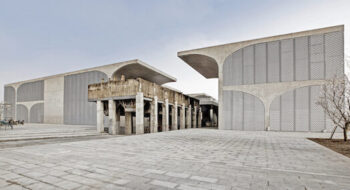
When it opened in 2012, the Long Museum Pudong was the largest private museum in China, founded by billionaire investor Liu Yiqian and his wife Wang Wei. Situated at a former coal-loading wharf by the Yangzi river, this museum of reinforced concrete uses industrial architecture in an impressive, utilitarian avant-garde design. This is one of three museums to feature one of the most important private Chinese art collections in the world. Although it is weighted towards and more celebrated for its contemporary works, the couple have also invested heavily at auction in pieces from Imperial and Republican eras, for example paying nearly $40 million for a tiny Ming dynasty “chicken cup” and controversially immediately celebrating the purchase by drinking tea from it! This building is comprised of several exhibition spaces. Although the previously excellent “permanent exhibition” (moved during Covid) is currently absent, the quality of art shown in this museum is always worthy of attention.
Address: 3398 Longteng Avenue, Xuhui District, Shanghai, Long Museum (West Bund)
Chinese Address: 上海市徐汇区龙腾大道 3398 号龙美术馆(西岸馆)
Web URL: http://www.thelongmuseum.org/en/
Adult ticket price: 320RMB
Closed Monday
2) Power Station of Art
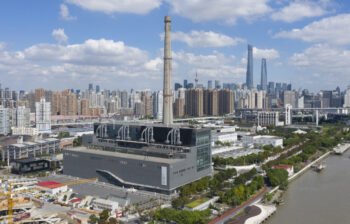
This is the most politically influential contemporary art museum in the city and possibly the country. Owned by the municipality of Shanghai, the state-run Shanghai Contemporary Art Museum, as it is known in Chinese, is the official host of the prestigious Shanghai Biennale. Housed in what was formerly the coal-fired Nansha electricity generation plant, the massive 41,000 m2 (410,000 square feet) space was converted into the Pavilion of the Future for the 2010 Shanghai Expo and two years after was re-purposed to house China’s first public contemporary art museum. There is no permanent exhibition – at any time you will find a number of high-quality temporary exhibitions of notable variety.
This museum is right beside the Team Labs exhibition space and so it would make sense to combine the two in a visit to this area.
Address: 678 Miaojiang Road, Huangpu District, Shanghai, 200011, Power Station of Art
Chinese Address: 海市黄浦区苗江路号上海当代艺术博物馆
Web URL: https://www.powerstationofart.com/whats-on
Adult ticket price: Exhibitions priced variously from 0 – ~100RMB
Closed Monday
3) China Art Museum
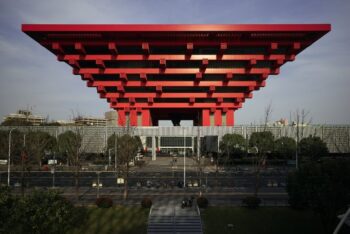
One of the most famous paintings in Chinese art history is the twelfth century “Along the River during Qing Ming festival” (清明上河圖), painted by Zhang Zeduan. This has been called China’s “Mona Lisa” to give you an idea of its importance. 25 cm (10 inches) high and 5.25m (17’) long, it features scenes by the Bian River in the then capital of China, Kaifeng. In scroll format, it reveals life in both rural and urban China at all levels of society. You can see it online here.
Whilst the original is in the Palace Museum in Beijing, the authorities were inspired by the towering historical grandeur of this piece when they sought to anchor The China Art Museum with a suitably impressive work of contemporary art. That is because this architecturally stunning museum, which you can view here, was launched as the iconic monument of the 2010 Shanghai Expo, which following on from the 2008 Beijing Olympics, became Shanghai’s calling card to global relevance in the new millennium.
What you can see here today is a 3D animated version of the classic scroll painting. Called “River of Wisdom”, 128 m long (420’) and 6.5 m (21’) high, this amazing computer graphic with moving figures brings to life the entire scene in 4-minute day and night cycles. If you have even the most fragmentary art history bone in your body, you will be fascinated by it, but please note that other than this exhibit, there’s little reason to inspect the contents of this museum.
Address:205 Shanghai Road, Pudong Xin Qu, Shanghai. China Art Museum
Chinese Address: 上海市浦东新区上南路205号中华艺术宫
Web URL: https://www.artmuseumonline.org/art/art/index.html#page1/1
Adult ticket price: Free admission to permanent exhibition, 20RMB for special exhibition
Closed Monday
4) Museum of Art Pudong
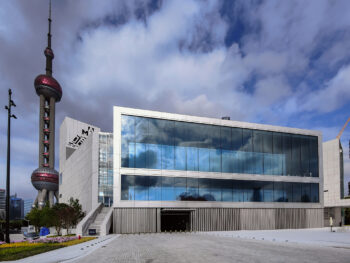
Owned by Lujiazui Group, a state-funded real estate company, primarily tasked with developing key aspects of the Pudong waterfront, the Pudong Art Museum is a 40,000 square meter space devoted to prominent temporary exhibitions in the heart of the city. Located beside the Oriental Pearl Television tower at the tip of the bend in the Yangzi river opposite the British-developed Bund embankment, this museum provides a cultural anchor for what is now probably the world’s most desirable real estate. The 13 galleries, designed by Pritzker winning French architect, Jean Nouvel, are so designed to accommodate both massive installations and the typical maze of whitewashed walls you’d typically expect to find. Also significant are the two glass fronted walkways looking onto the Bund as well as the magnificent views from the roof restaurant and terrace beside it. You should expect to find high quality exhibitions here whenever you visit – for example at the time of writing, the photographic works of Lin Heung Shing, spanning half a century of Chinese history, were featured beside a retrospective of Zeng Fanzhi, one of China’s best known contemporary artists, as well as a fabulous installation by Xu Bing.
Address: The Museum of Art Pudong , No.2777 Binjiang Avenue, Pudong New Area, Shanghai
Chinese Address: 上海市浦东新区滨江大道2777号浦东美术馆
Web URL: https://www.museumofartpd.org.cn/en/index
Adult ticket price: 200 RMB (weekend ticket)
Closed Tuesday
5) Yuz Museum
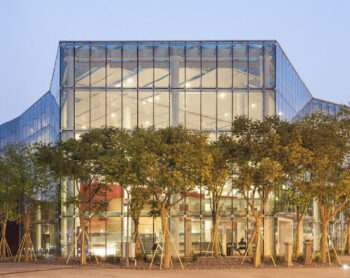
Mr Budi Tek, who passed away in 2022, was one of several successful Indonesian-Chinese entrepreneurs to invest in contemporary Chinese art during its recent rise to prominence. His particular penchant was for installation art, especially very large pieces. His beautiful museum, built on the site of a former hangar of Longhua airport, now houses a portion of his impressive collection as well as offering temporary exhibitions to established artists. It is well worth a visit as part of your investigation of the West Bund area.
Address: No.8, Lane 123, Panding Road, Qingpu District, Shanghai, Yuz Museum
Chinese Address: 上海市青浦区蟠鼎路123弄8号余德耀美术馆
Web URL: http://www.yuzmshanghai.org/?lang=en
Adult ticket price: 140RMB
Closed Monday
6) Team Labs

The absolutely spectacular international digital art collective, founded in Japan in 2001, offers a wonderfully immersive 3D digital display at the Epsom Team labs venue close to the Powerstation of Art in the West Bund area in Shanghai. If you have seen one of these before, then this won’t be quite so fabulous, but if you’re a first-timer, this is a must-see.
Address: Unit C-2 No 100, Huayuangang Lu, Huangpu, Shanghai , Team Labs
Chinese Address: 上海市黄浦区花园港路100号C-2馆无界美术馆
Web URL: https://www.teamlab.art/e/borderless-shanghai/
Adult ticket price: 249RMB (for weekend or weekday entry)
7) Fosun Foundation
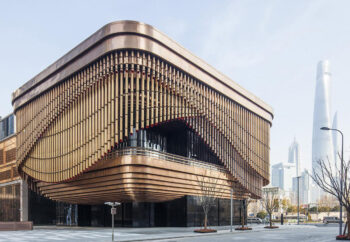
This exhibition space is prominent thanks to the kinetic installation around the museum building. Designed by Brit, Thomas Heatherwick, who created a sensation with the UK Pavilion at the Shanghai Expo and more recently with the 1000 Trees development near the M50 galleries, the perimeter of the museum roof is circled by three layers of bronze tubes of varying lengths hanging down from rails. At regular times of the day, the tubes that resemble waves of bamboo trunks or inverted organ pipes move around the building, revealing a terrace or stage within. Located within the Bund Financial Centre, a smart (in both senses) real estate development, the Fosun Foundation becomes a destination in its own right even without the benefit of the temporary exhibitions it regularly features. The quality of the exhibitions (and the ticket prices) vary from good to excellent, but really both the exterior of the Foundation and the development it introduces are worth a trip in themselves.
Guo Guangchang and his Fosun Group are worthy of a short word. In brief, five young graduates from Fudan University, one of China’s finest, clubbed together in 1992 to start an investment company. Here we are thirty-five years later and it’s one of the largest conglomerates in the world, owning amongst other assets Wolverhampton Wanderers FC, a Premier League football club (soccer), Thomas Cook, the venerable travel firm and Club Med. Congrats to them!
Address: Fosun Foundation, Bund Finance Centre, 600, Zhongshan East 2nd Road Shanghai 200010
Chinese Address: 上海市黄浦区中山东二路600 号200010复星艺术中心
Web URL: https://www.fosunfoundation.com/en/
Adult ticket price: 40 – 300RMB according to exhibition
Closed Monday except public holidays
8) West Bund Project (Pompidou)
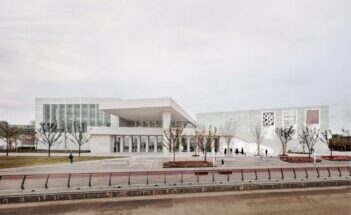
Whilst the David Chipperfield-designed West Bund Museum is one of the city’s most prominent new museums, its politically-inspired ten-year relationship with the Georges Pompidou Centre means that it more naturally commands the attention of local Chinese interested in traveling exhibitions of French art than visiting foreigners investigating local Chinese talent.
“Mirrors of the Portrait. Highlights of the Centre Pompidou collection” is the third and current semi-permanent exhibition from the famed Parisian collection. This will run from July 2023 to November 2024, to be replaced by other differently-themed collections from the same European museum. Reflecting the museum’s dual role also reflecting Chinese art’s role on the global stage, a secondary concurrent exhibition typically extols the merits of a local artist. In addition, the museum features other temporary exhibitions, details of which can be accessed on its website.
Address: No.2600 Longteng Avenue, Xuihui District, Shanghai, West Bund Museum
Chinese Address: 上海市徐汇区龙腾大道2600号西岸美术馆
Web URL: https://www.wbmshanghai.com/en/
Adult ticket price: 100RMB for Pompidou exhibition, 200RMB for all exhibitions
Closed Monday
The reopening of international travel to China in March 2023 has introduced visitors to changes in rules for accessing Tiananmen Square and for buying tickets to the Forbidden City in Beijing. If you are working without the help of a luxury tour operator such as Imperial Tours, which can organize these tickets as part of an custom package, but want to organize these activities for yourself, the instructions below detail how to do it.
To Access Tiananmen Square (Without Visiting The Forbidden City)
As of 2021, travelers must make a reservation to Tiananmen Square at a particular time to access it. The most convenient way to organize this is to download the Wechat app and look in the search bar for a mini-app called “天安门广场预约参观”. Unfortunately, an English language version is not yet available. Double-click on the mini-app to open it and then click on “个人预约” which means “Individual Ticket Ordering”. The next screen in Chinese provides dates for entry. Once you have selected a suitable day, the next screen offers four choices: 升旗 (flag raising for which you should arrive before dawn), 上午 (morning), 下午 (afternoon), and 降旗 (flag lowering in the evening). The following screen asks for the personal information of every visitor including the surname (姓名), type of identity document (证件类型), for which your answer should be passport (护照), passport number (证件号码) and mobile phone number (手机号码). Please note that families with children under 6 years of age or less than 1.2 meters (47 inches) in height should request children (儿童). Once you complete this information for all the passengers, you will arrive at a screen with a reservation number detailing your visit time along with your total adult and children tickets.
Now that you have reserved a time to visit, you should proceed to one of the entry points to Tiananmen Square at the reserved time, remembering to take your passports with you. There will be a line for the security inspection prior to accessing the square where your passport will be confirmed against the reservation system, you will be asked to pass through a metal detector scan and any bags you have with you will be examined. If it is a hot day, please remember to take a bottle of water!
To Purchase Tickets For The Forbidden City And Tiananmen Square
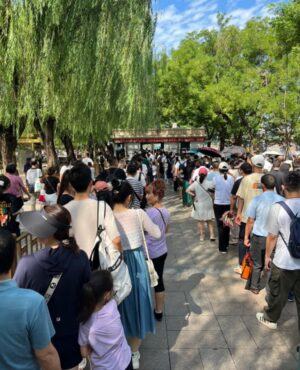
The process for purchasing tickets for the Forbidden City has also become more onerous. Imperial Tours can simplify this for you greatly taking care of all the admin and also reducing the time you will have to queue at the site to collect your tickets prior to queuing to access the site. Should you wish to do this for yourself, you can easily reserve tickets up to 6 days in advance at the English language website. On this website, you select the time for your visit, along with the number of visitors and enter the passport information for each of the visitors. The website charges a US$3 per ticket booking fee and gives you the right to queue up and purchase tickets at 60RMB per ticket before your visit.
It makes sense to arrive at the Forbidden City in good time for your visiting slot as you will need to find your way to the ticket office on the west side of Wumen or Meridian Gate. Once there, you will find there is a queue of 10 – 50 minutes to get to the ticket window, where you can purchase your tickets at 60RMB per ticket. Once you have bought your tickets, you should advance to the queue for entry for individual ticket holders. Fortunately, this is a much quicker queue and you will only need to wait here for about 5 – 20 minutes in order to get into the Forbidden City and start your visit. Note that once you get your reservation to purchase tickets for the Forbidden City, you can automatically use the same reservation to gain access to Tiananmen Square at the same time so long as you are not visiting the flag raising or lowering ceremony – these require a separate application, as described above.
Should you wish to use the services of Imperial Tours to develop a tailored luxury tour package, you will find that you will access both Tiananmen Square and the Forbidden City with shorter or no queue times and far less hassle.
Tomb Sweeping Festival, or Qingmingjie in Mandarin (pronounced Ching-ming-jair), is a three-day public holiday in China, making it the perfect time for a luxury China tour. Literally translating to the Pure Brightness festival, Qingmingjie is the day when people pay their respects to ancestors, traditionally by cleaning the graves and burning offerings. However, since this day usually falls on the 4th or 5th of April, the occasion is often used to mark the start of spring. Given the three day holiday, people may go on outings to enjoy the first hint of warmer weather, or even opt for domestic travel to another city, visiting the 5 Star offerings available in this fast developing luxury travel market.
Qingmingjie began over 2,500 years ago in the Zhou dynasty. Emperors and officials frequently held lavish ceremonies in honour of their ancestors, offering sacrifices and praying for a good harvest, health and prosperity. Over the years this morphed into the tradition of cleaning ancestors’ graves and burning food and paper, representing money, to bless them in the afterlife. The date of the festival, on the first day of the Qingming, or second, solar term, was fixed by Emperor Xuanzong, of the Tang dynasty, who decreed in 732AD that respect could only formally be paid at ancestors’ graves on this day. It’s a tradition since respected by officials and commoners alike.
Traditionally, Qingmingjie was the day when families would go together to the grave of their ancestors. They would spend the day digging up weeds, adding fresh soil and perhaps sticking willow branches, flowers or plastic plants on the tomb. They would also leave offerings of food and tea, or wine, as well as burning incense or artificial paper money, as it is believed that burning such things at a grave makes them available for use in the afterlife. They would also pray to their ancestors and ask them to watch over and bless the family.
If visiting friends or neighbours during this time, you’re likely to see willow branches hanging next to front doors to ward off evil spirits, which are thought to wander during Qingming. The use of willows specifically is homage to the Buddhist Goddess, Guanyin, who is usually depicted with a willow branch and a vase of sweet dew to banish demons. Guanyin also inspires the popular Hong Kong dessert, Yangzhiganlu (杨枝甘露), a feature of our popular food tour in Shanghai, as the sweetened coconut milk and sago in the dish represent the sweet dew and the willow branches.
Kite flying is also an important tradition of Qingmingjie. Young and old alike will often take to the park to fly kites with lanterns tied to the strings in the belief that this can bring good luck. Sometimes the kite strings will be cut, to allow the kite to fly free. Kites can even be seen flying into the evenings when the lanterns on the strings can appear like stars or fireflies dancing in the night sky. A fun activity for those travelling with children. Since the festival is marked by a three-day national holiday (actually just one day plus the weekends, as explained here), nowadays people often take the chance to celebrate the beginning of spring by taking a short trip out of the cities, or visiting parks and gardens to get glimpse at the emerging spring blossoms.
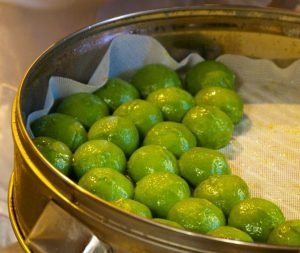
The most traditional food, which you’ll see everywhere in the weeks leading up to Qingmingjie, is undoubtedly the Qingtuan, literally meaniing “green ball”, and that is exactly what it looks like! A sticky, sweet, almost luminous green ball of paste wrapped in clingfilm and much tastier than the description would have you believe! The outside, green part is made of glutinous rice mixed with vegetable juice to produce the colour. Then inside is a sweetened red bean paste, which can sometimes be a bit of an acquired taste to the Western palette, but is a staple in many far eastern countries. The qingtuan is then eaten directly out of the clingfilm covering as a tasty sweet treat. Originally, Qingtuan were eaten on the “Cold Food Festival”, which was usually one day before Qingmingjie. However, over time, these festivals have merged together, and very few places now celebrate the two separately. Thus, the vast majority of people will tell you that Qingtuan are a traditional Qingmingjie snack.
Either way, if you’re visiting China in late March or early April, the Qingtuan really have to be tried! A food tour makes the perfect way to spend an evening on your luxury China tour, giving you an ideal opportunity to sample these special treats.
“I’m personally an atheist, but the concept of having a day to visit the family graveyard appears valuable to me, because I think sometimes it’s the living one that need to feel connected to a ‘root’.” -Sonia, 29
April is a wonderful time for a China tour, with the weather becoming pleasantly warm across the whole country. Many cities on your luxury travel itinerary will include the option to visit Buddhist or Taoist temples, where you can see, and even participate in, the practice of burning incense sticks. Traditionally three incense sticks are lit and held during prayer and this incense is available to buy near the entrance to most temples. The Lingyin Temple in Hangzhou is particularly special, since just outside it is a long promenade with caves containing statues of many different Buddhas carved into the rock. A rare and impressive site! It’s also joined to the luxurious Aman hotel, offering indulgent massages and spa treatments after a long day’s touring.
As you visit Shanghai, keep your eyes open in the markets of Yu Gardens too, as you may see some of the paper money to be offered as a sacrifice available to buy. An unusual and poignant souvenir for those wishing to tell stories of the cultural tradition of Qingmingjie on their return home.
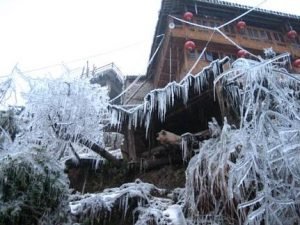
A trip to China would not be complete without a visit to Yangshuo area, in the south of China. If you have seen the movie The Painted Veil, this was shot mainly in Guangxi province, officially called the Guangxi Zhuang Autonomous Region. It is one of five so-called autonomous regions where the number of ethnic minority groups are higher than in other places – in Guangxi, it is the Zhuang minority (the Mongols in Inner Mongolia, Tibetans in Tibet, Uyghur in Xinjiang and Hui in Ningxia). While they still answer to the federal government, they benefit from more independence in finance, economic planning, arts and culture. The spoken and written languages of these ethnic groups are protected, with greater or lesser success…
A few years ago friends visited us in December and wanted us to take them to see off-the-beaten-track China. We flew from Shanghai to Guilin (2h50 flight), took a bus to Yangshuo, then a smaller bus to Ping´an, famous for the Longsheng rice terraces. As it was winter everything was covered with a thin layer of snow and ice. The bus driver started talking to the passengers in the front and pointing at us four. I could not understand because they were speaking Zhuang dialect, but I caught the word «laowai», slang for foreigner. Suddenly the bus stopped and somebody instructed us to get off the bus in Mandarin. “You are laowai, the road is too slippery and we can´t take the risk with foreigners. Please get off now.” So there we were, stranded on the side of the road, freezing cold with our backpacks, watching as the bus sped off. In a way, we were glad that they kicked us off because we trusted our legs more than that skating bus! (If only we had paid for an Imperial Tour rather than gone off back-packing by ourselves!) After a two hour hike up, we finally made it to Ping´an. I had visited the area in spring and fall when the rice terraces are covered in a wide range of green shades, but this time everything was white. It was incredible and I could not believe my eyes. Unfortunately, since everything was frozen, the water pipes in our hotel were frozen too which meant no hot water or heating. But as we hiked through the scenic, fairytale landscape wrapped withgloves, hats, scarves, it really did not matter!
Rice terraces in Longsheng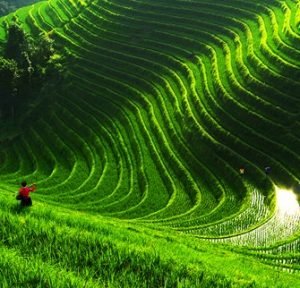
Now as I am sure you are thinking, this is not really my definition of luxury China travel! And you are absolutely right. That is why Imperial Tours’ guests usually spend two nights at the luxurious Banyan Tree Resort (one of China’s top five luxury rural getaways) in Yangshuo, where one wakes up surrounded by karst peaks. Here you venture on a traditional bamboo raft for a relaxing ride along the Li River in the early morning to avoid the crowds. The remainder of the day is spent exploring the beautiful countryside, by bicycle or by car, wandering through rice paddies and learning how to make soy milk and tofu from villagers.
For those who would like to spend more time in the area, we can arrange a night or two in Ping´an at the Li´an Lodge (while relatively basic and not at the level of our typical five-star hotel choices, accommodation is clean and comfortable). You will be led on a hike between several minority villages, offering you the best views of those spectacular terraced rice fields carved into the hillsides more than 500 years ago by Zhuang minority farmers.
All without frostbite, we promise!
– Gwen is an itinerary designer at Imperial Tours.
Read this post from Guy Rubin to learn more about the region’s history.
Just to the south of Hong Kong lies Macau. This tiny territory of just under thirty square kilometers must be one of the few places in the world where a former colony boasts a higher per capita income than the parent country. Macau was settled while the Portuguese were acting as middlemen for trade between the Chinese and Japanese during the sixteenth century. These days it is internationally known for the casinos, whose revenues now better those of Las Vegas, but beneath that all-encompassing industry a small segment of Europe has lived on inside the Chinese world. The British poet, W. H. Auden, visited many years ago and wrote a poem which began: A weed from Catholic Europe, it took root Between the yellow mountains and the sea, And bore these gay stone houses like a fruit, And grew on China imperceptibly … And finishes with a line that Auden presumable meant as a slight ‘and nothing serious can happen here’. but which may have helped preserve some of the charm and tastes of the Portuguese world. These range from the ruins of the Church of St. Paul and a cemetery through which you can trace the history of the settlement, to the foods be they simple bread or substantial Macanese fare. Some of the numerous gaming revenues that the small territory which, like Hong Kong, has reverted to China, have been put to use in providing public services and expanding the university.
FOR IMMEDIATE RELEASE: August 14, 2017
Contact: Jacqueline Soto, 480-430-7511, Jacqueline@slentertainment.com
Guy Rubin, +86 10 8440 7162 guy@imperialtours.net
IMPERIAL TOURS GREAT WALL PRIVATE BANQUET RECOGNIZED AMONG TOP TRAVEL EXPERIENCES
Scottsdale, AZ – An experience offered by Imperial Tours was recognized as one of the top experiential travel offerings at the inaugural CHAD CLARK CERTIFIED 25, a first-of-its-kind travel initiative that annually lists the top 25 travel experiences or products throughout the world. The winners were announced in a special interactive event at the Bellagio in Las Vegas on August 13 in front of leading travel professionals.
Chad Clark, principal and owner of Chad Clark Travel Ventures, is a travel industry expert and self-described, “experience junkie,” who has spent years seeking out top-of-the-line travel experiences and services. Now, he is providing a platform for the best in travel to share theirs.
Clark aims to set the industry standard for luxury travel with the inauguration of the CHAD CLARK CERTIFIED 25, an elite list of the world’s most prestigious, authentic and unique travel experiences or products. Great Wall Private Banquet was among the first recipients of this prestigious honor.
“We are humbled and overwhelmed by the immense number of submissions we received from travel providers across the globe,” said Clark. “It is an honor and a thrill to unveil the very best in luxury travel through the CHAD CLARK CERTIFIED 25. This initiative provides travel suppliers with an opportunity to have their premium experiences recognized and promoted in an innovative way, while simultaneously connecting travel advisors, and ultimately travelers themselves, with exclusive, thoroughly vetted travel experiences that have an industry seal of approval.”
About the Great Wall Banquet
When we hear these days of the daunting logistical and financial challenges of building a wall across the southern border of the US, it brings home the magnificent achievement of the Chinese in resolving exactly these issues many centuries before as they built successive fortifications across their northern frontier to protect their agricultural heartlands from aggressive nomadic invaders from the north. These fortifications are known to us today as the Great Wall of China. The incredible experience we are presenting is the opportunity to walk the Great Wall with the British conservationist who was instrumental in developing the law to protect it, and then to enjoy a white linen banquet in a guard tower.
What astounds visitors about the Ming dynasty Great Wall (1368-1644) is its surprising beauty. Whereas the sections closest to Beijing are the largest with the most tourists, more remote sections benefit from fewer visitors and less renovation. The centuries-old 5 meter high “wild wall” – as conservationist William Lindesay calls it – these days does not dominate its surrounding landscape so much as delineate, define and embellish it. William will introduce his thirty year association with the Great Wall, starting with being the first foreigner ever to walk its entire length, to now when he is known through China as the Guardian of the Wall. After a thorough introduction to his efforts to improve its conservation, you will be taken to a remote spot to enjoy a remarkable banquet on the Great Wall of China.
About Chad Clark Travel Ventures
A self-proclaimed “experience junkie,” Clark gave up corporate life to follow his love for food, wine, culture, destinations, a.k.a. extraordinary travel experiences, and turn it into a business that helps people make the absolute most of their most precious commodity – their time.
Whether traveling with friends, family or alone on a research trip, Clark is all about the experience – and when he finds one he is passionate about, he just has to share it with his clients and friends. He and his company have the contacts, relationships and dedication necessary to ensure his clients have the best possible experiences. Clark has dedicated his life to travel and is amassing an ever-growing “Experience Journal” that he shares online through social media. Viewers can follow Clark through Rome, Sydney, Paris and even in his own backyard golfing in Scottsdale, Arizona. Clark and his team are committed to sampling, connecting, building relationships and, in essence, helping his clients live their next big adventure.
Chad Clark Travel Ventures works with people who recognize that the types of trips they want require more than time and planning – they require knowledge, experience and connections, all of which Clark and his team can provide.
Chad Clark Travel Ventures, an independent affiliate of Camelback Odyssey Travel – a Virtuoso® Member.
For more information on CHAD CLARK CERTIFIED 25, please visit www.chadclarkcertified.com.
The Year of the Rooster
Chinese New Year, also referred to as Lunar New Year and Spring Festival, is the biggest and most important holiday in China. In terms of significance in Chinese culture the Lunar New Year is comparable to combining Thanksgiving and Christmas together. We have assembled some traditions and facts behind one of the world’s largest celebrations to provide a better understanding of this holiday. We have also put together some useful travel tips should you wish to experience this festival first hand.
The tradition of Chinese New Year is said to have started thousands of years ago when, at the end of a cold and hard winter, a mythical beast called Nian would storm into Chinese villages and devour all the men, women and children residing there. Full of fear and with no means to defend themselves the villagers would hide in the surrounding bamboo forests to wait out the night and the wrath of the beast. Until one year, tired of hiding, a brave old man decided to face the beast alone. In preparation for his fateful encounter, the old man hung up red flags and banners; he then cut fresh bamboo to light a fire. Once on fire the green bamboo created such loud cracking sounds that the monster, upon hearing the noise and seeing the many red colors, was scared away. And so as legend goes, from that day on people no longer had to fear the beast. Advancing forward thousands of years, it is now tradition that at the end of winter people across China gather together to celebrate, hang red banners and lanterns, wear red clothing and light firecrackers.
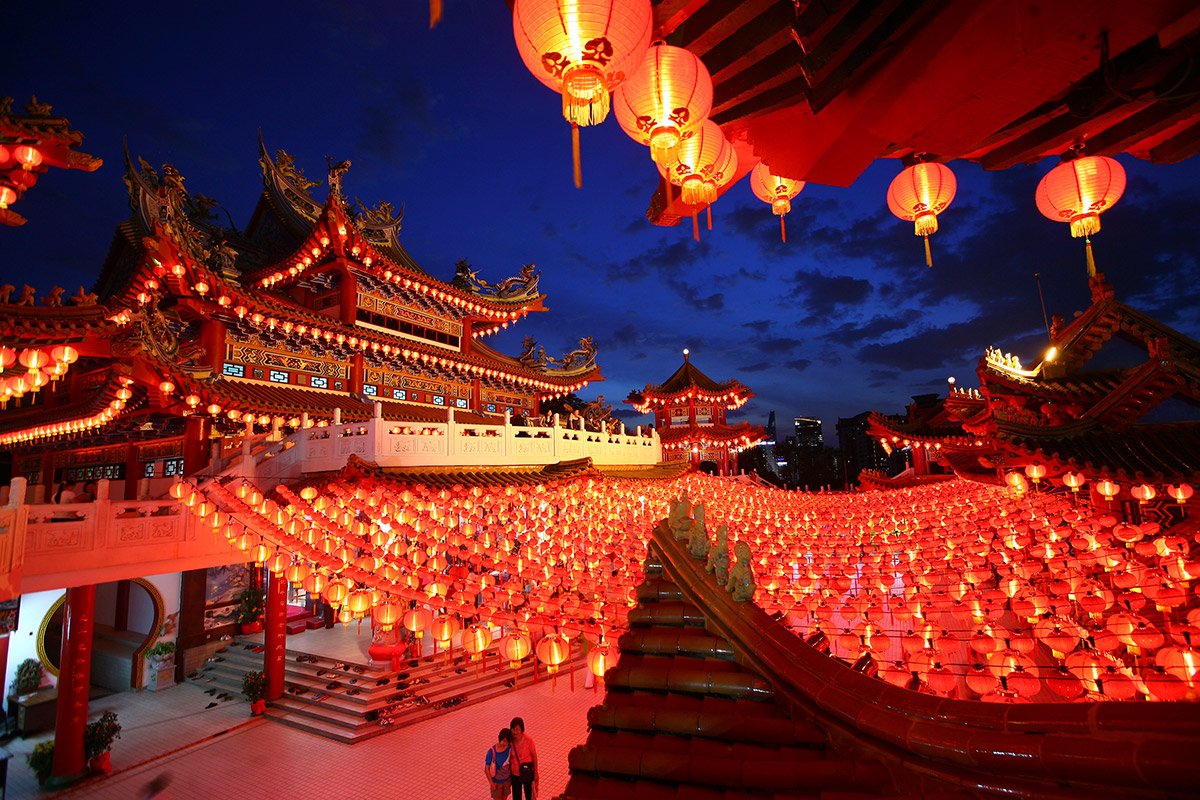
Red Lanterns in Beijing at Chinese New Year/span>
Chinese New Year is a 15-day celebration following the lunar calendar, this means that the date of the holiday changes each year. Generally, Chinese New Year falls between the end of January and the beginning of February. In 2017, January 28th was the first day of the New Year, marking the beginning of the year of the Rooster. Outside China countries such as Indonesia, Malaysia, South Korea, Taiwan and Singapore also recognize and celebrate the festival. Chinese New Year is actually the biggest migration on earth. Over the holiday there are an estimated 650 million people traveling, either throughout China or overseas to visit friends and family. Much like Christmas and Thanksgiving, in Chinese culture over the Lunar New Year it is customary for families to spend time together. For those individuals who have have moved into bigger centers, such as Beijing or Shanghai for work or study, the New Year festival is a time to travel home. For many people, this is the only time of year when they will have time to reunite with their families. Officially, this mass migration begins two weeks before New Years Eve and ends two weeks after; this transport period is referred to as Chun Yun. The Chinese New Year festival is also responsible for the largest television broadcast in the world. Since 1983, CCTV (China Central Television broadcasting company) has hosted a lavish six-hour Spring Festival Gala. The gala is called Chun Wan and is essentially a variety show featuring traditional Chinese performances showcasing China’s vast culture and history. With approximately 800 million viewers, this is the largest entertainment show broadcast globally. Since its origin, Chinese New Year has evolved to incorporate new customs and traditions, which can vary from place to place and family to family. However there are some universal traditions that the majority of those celebrating Chinese New Year recognize. We have created a list of seven common customs followed during the New Year festival.
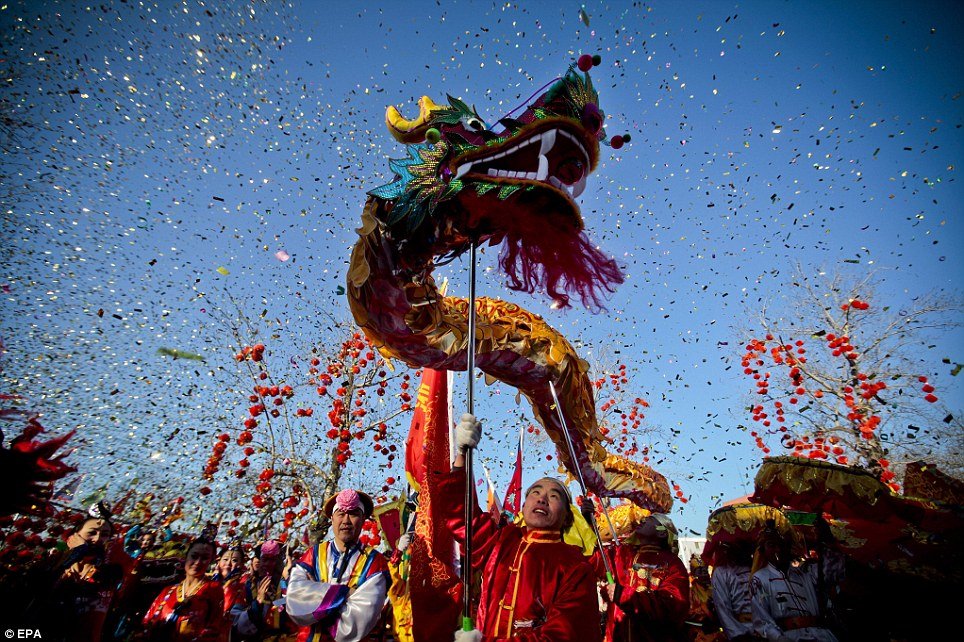
Traditional Chinese New Year Customs
Spring-Cleaning
Several days before the Lunar New Year is set to commence it is customary to perform a spring-cleaning of your home to sweep any ill fortune away. This is also the time to stock up on snacks and food to prepare for the festivities, much like what happens in the days prior to Christmas. This preparation is important as during Chinese New Year it is believed that one should do as little work as possible. It is also considered bad luck to use a knife, light a fire or even use a broom on the first day of the New Lunar Year.
Traditional Red Clothing & Decorations
In line with tradition, at Chinese New Year it is customary to decorate your home with traditional red lanterns and red banners. Across China red banners with auspicious poems written on them are hung outside doors to bring good fortune, wealth, happiness and longevity. In ancient China, New Year was also typically the time when people bought or traded for new clothing. In present-day China, it is customary to buy and wear red clothing, even underwear during this period.
Family Gatherings
It is traditional on New Years Eve for the family to congregate at the husband’s family home, then, on the second day of the New Year, the family would go to their maternal relatives for a visit and celebration. However, during the Lunar Festival the theme is generally ‘the more the merrier’ and generally distant relatives will gather together to celebrate regardless of family ties.
Lucky Foods
Symbolism in China is of utmost importance; even the food that is served and consumed during the New Year festival holds significance. Traditionally, fish is eaten for the New Year’s meal. In Chinese the word fish (yú) sounds similar to the Chinese word for ‘surplus’. Fish is consumed to ensure that each year there will be surplus. However, the fish is never eaten completely as this again symbolizes surplus. Other ‘lucky’ foods include mandarin oranges (júzi) as their name is a homophone of the word for success in Chinese. Another popular food with homophonic meaning is Niangao or glutinous rice cake, which sounds like ‘a more prosperous year’. Additionally, spring rolls and dumplings are eaten because of their similarities to ancient Chinese silver and gold ingots.
Firework Displays
In line with the tradition to scare away the Nian, at midnight on New Years Eve, to ring in the New Year people all over China go outside to set off a barrage of firecrackers and fireworks. However, this practice is not restricted to New Years Eve alone, every night for the next two weeks fireworks are lit until the last day of the festivities when anything that is left is set off.
Temple Visits & Temple Fairs
After the festivities and fireworks the night before, on the morning of New Years Day people congregate at Buddhist temples to give their offerings to the gods. While not everyone in China practices Buddhism, many Buddhist traditions have intermixed with folk customs and it is customary to burn incense at the temples as well as make a donation to wish for a smooth and successful next year. This is often combined with a visit to a traditional temple fair.
Traditional Gifts The five days following New Year’s Day are dedicated to eating, drinking, visiting relatives and playing mahjong. During this time it is traditional for older relatives to give children gifts of red envelopes with money called Hong Bao. The values vary from family to family, but typically Hong Bao’s consist of monetary values containing lucky numbers such as 6, 8 or 9. With the advancement of technology it has now also become popular for friends and family to send each other Hong Bao’s over the messaging service Wechat.
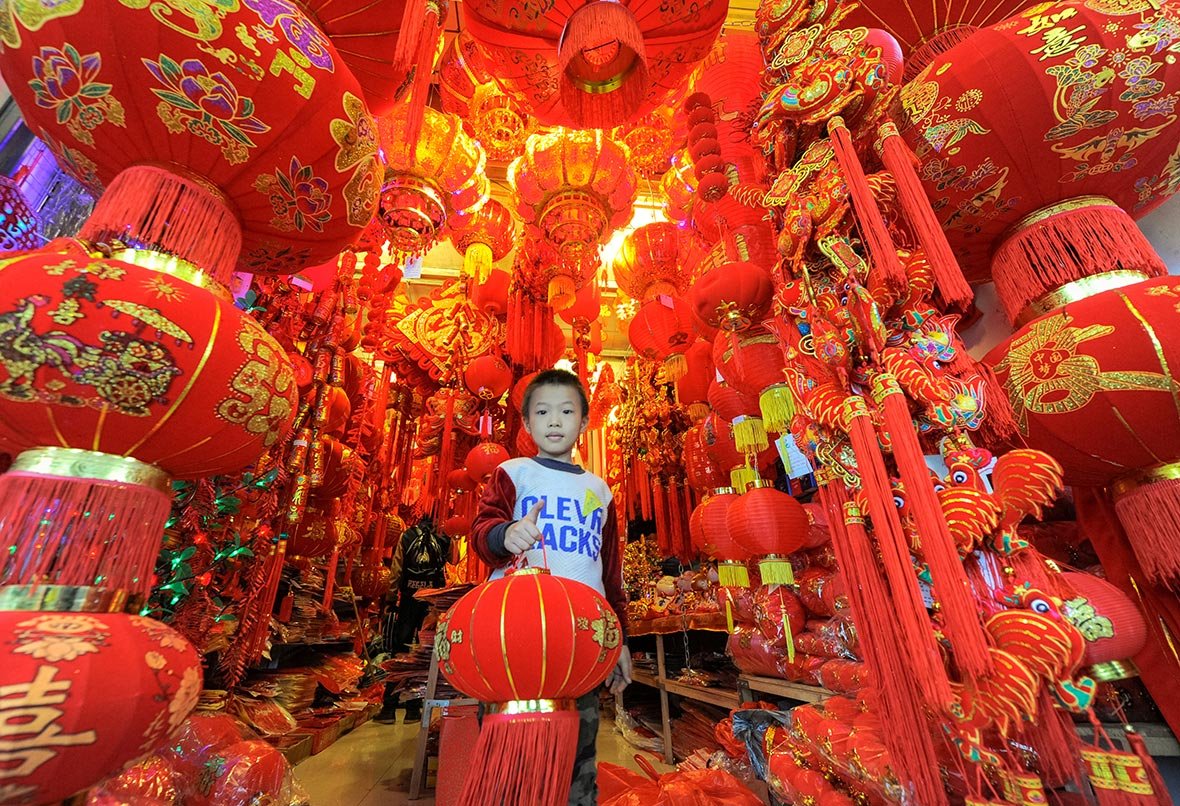
Traveling During the Chinese New Year Festival
Because most businesses are closed for the holiday, we do no recommend traveling during the first week of Chinese New Year. However, in the second week business starts to picks up again, as people return from their holidays the hustle and bustle of modern China slowly returns. If you do wish to come during this period there are some fun and cultural experiences we recommend doing.
Attend a Temple Fair
Visiting a Chinese New Year Temple Fair, called a Miao Hui, is a great way to experience Chinese culture around the Spring Festival. These temple fairs are set up in large city parks and feature arts and crafts as well as traditional performances. Many temple fairs have evolved into bazaar-like events with parts of the park dedicated to arcades where one can try one’s luck at winning an oversized teddy bear and various other prizes. These fairs are also great for trying a multitude of traditional Chinese snacks that are often only available during Chinese New Year.
Fireworks
Over 2,000 years ago China invented fireworks, so it is no surprise that watching and lighting fireworks during the New Year festival can be quite inspirational. On every large street corner temporary shops set up selling boxes of fireworks of various types. During the festival you can expect to see firework displays every evening. In recent years the government has tried to discourage citizens from lighting fireworks in the city due to fire hazards, but this rule goes largely ignored and is often not enforced.
Chinese Zodiac Animals
|
|
Characteristics |
Years |
|
Rat |
Intelligent, adaptable, quick-witted, charming, artistic & sociable. |
2020, 2008, 1996, 1984, 1972, 1960, 1948 & 1936 |
|
Ox |
Loyal, reliable, thorough, strong, reasonable, steady & determined. |
2021, 2009, 1997, 1985, 1973, 1961, 1949 & 1937 |
|
Tiger |
Enthusiastic, courageous, ambitious, leadership, confidence & charismatic. |
2022, 2010, 1998, 1986, 1974, 1962, 1950 & 1938 |
|
Rabbit |
Trustworthy, empathic, modest, diplomatic, sincere, sociable & caretakers. |
2023, 2011, 1999, 1987, 1975, 1963, 1951 & 1939 |
|
Dragon |
Lucky, flexible, eccentric, imaginative, artistic, spiritual & charismatic. |
2024, 2012, 2000, 1988, 1976, 1964, 1952 & 1940 |
|
Snake |
Philosophical, organised, intelligent, intuitive, elegant, attentive & decisive. |
2025, 2013, 2001, 1989, 1977, 1965, 1953 & 1941 |
|
Horse |
Adaptable, loyal, courageous, ambitious, intelligent, adventurous & strong. |
2026, 2014, 2002, 1990, 1978, 1966, 1954 & 1942 |
|
Sheep |
Tasteful, crafty, warm, elegant, charming, intuitive, sensitive & calm. |
2027, 2015, 2003, 1991, 1979, 1967, 1955 & 1943 |
|
Monkey |
Quick-witted, charming, lucky, adaptable, bright, versatile, lively & smart. |
2028, 2016, 2004, 1992, 1980, 1968, 1956 & 1944 |
|
Rooster |
Honest, energetic, intelligent, flamboyant, flexible, diverse & confident. |
2029, 2017, 2005, 1993, 1981, 1969, 1957 & 1945 |
|
Dog |
Loyal, sociable, courageous, diligent, steady, lively, adaptable & smart. |
2030, 2018, 2006, 1994, 1982, 1970, 1958 & 1946 |
|
Pig |
Honorable, philanthropic, determined, optimistic, sincere &sociable. |
2031, 2019, 2007, 1995, 1983, 1971, 1959 &1947 |

Marketing China has never been more exciting, easy and profitable. As you may know Imperial Tours has partnered with Peninsula Hotels to bring you Peninsula Private Jet Tours Through China. Through this collaboration we have developed three bespoke travel experiences through China: Culture & Heritage, Family and Culinary. But what you may not know is that we have also developed a marketing plan designed to help you get the word out about these itineraries. Our Marketing Plan gives you the tools you need to promote and share Peninsula Private Jet Itineraries through multiple mediums. The idea behind sharing our marketing plan with you is to take the guesswork out of promoting these experiences. Essentially, let us do all the work for you and all you need to do is share!
These itineraries are packed full of once-in-a-lifetime experiences. If they are booked privately, itineraries can be further customized for alternative dates or embellished with different destinations, and if wished they can also be booked on commercial flights.
Our Marketing Calendar (click to download) is complete with step-by-step instructions on how to market and capitalize on each itinerary. All you have to do is follow five easy steps and let Imperial Tours do the rest.
Follow us on Twitter, Facebook and Instagram to get content on Peninsula Private Jet Tours that you can share with your followers.
Click to download our Marketing Calendar made especially for you. This calendar provides you with a detailed, easy to follow, marketing campaign that you can print out and follow to promote these tours. Additionally, our Marketing Calendar provides you with easy to follow instructions on how to repost and share from Facebook, Twitter, Instagram and E-blast.
Over the next 3 months, starting in November 2016, we will be sending out 3 e-blasts relating to a specific Peninsula Private Jet Itinerary; Culinary, Family and Culture & Heritage. Each e-blast will be created so that you can forward the information to anyone you think might be interested in one of these amazing experiences.
Each one of our 3 e-blasts will have a social share button that allows you to share each itinerary on Twitter, Facebook & Instagram. Simply click the social share button for each social icon and share!
After generating interest in each tour contact us to help you book one of these amazing journeys. Note: private tours based on these scheduled departures can fly commercial and be further customized.
Our Culinary Voyage e-blast will be sent shortly after American Thanksgiving. This one of a kind itinerary provides opportunities for your clients to try their hand at creating traditional Chinese dishes such as Peking duck, Dim Sum and even noodle throwing. China is a “must-eat” destination for all foodies; our Culinary Voyage is a 10-day tour highlighting the best eats China has to offer. Our culinary tour is ideal for groups of 8 or less. Tours are approximately USD$26,050* per person based on double occupancy. To view a detailed itinerary click here.
Our Family Tour e-blast will be sent in early December, in time for Christmas as the perfect once-in-a-life-time holiday gift for the whole family. This 11-day tour showcases the best of China in a safe and family-friendly interactive setting. This tour is ideal for small to medium sized families who are looking for a unique holiday experience and enjoyment for the whole family. Tours begin at approximately USD$102,120* per family of 4. To view a detailed itinerary click here.
Our Culture & Heritage itinerary will be sent out after the New Year and is equipped with unparalleled access to some of China’s most significant cultural artifacts as well as leading creative minds shaping China’s artistic landscape. This 10-day tour will introduce you to private collections and VIP access to China’s cultural treasures. This tour is ideal for clients who are looking for exclusive access to all that China has to offer. This tour is suitable for small groups as well as families. Pricing begins at approximately USD$25,530* per person based on double occupancy. To view a detailed itinerary click here.
*Price is subject to change based on fluctuating exchange rates.
Imagine exploring three of the worlds most dynamic and fast paced cities from the comfort and convenience of a private jet. Imperial Tours has partnered with Peninsula Hotels, renowned for flawless service and quality, to provide you with the ultimate China experience, Peninsula Hotels’ Private Jet Tours. We have crafted three themed itineraries – Culinary, Family and Culture & Heritage – each designed with immersive experiences to captivate you while introducing the rich culture, cuisine and history of China.

Experience a journey like no other on a Peninsula Private Jet Holiday
For many people, the thought of visiting China sparks a sense of wonder and excitement for the mysterious culture of the East. As one of the most populated and diverse countries in the world, China provides a cornucopia of experiences engaging all the senses. While this temptation to discover the East is an enticing lure it can also be overshadowed by fear of the unfamiliar. With Peninsula Hotels’ Private Jet Tour itineraries you will experience the reassuring comforts, anticipatory service, and soothing attention to detail of legendary hotelier, Peninsula Hotels. In this way, the exoticism and mystery of the East can be enjoyed from the reassuring platform of some of the world’s leading hotels.
Each tour provides access to one-of-a-kind bespoke experiences only available as a result of the partnership between Imperial Tours and Peninsula Hotels. For example, you will explore a seafood bazaar in Hong Kong with the Executive Chef of the Peninsula Hong Kong and learn to paint with the Peninsula Beijing’s resident artist. Alternatively, try climbing aboard Peninsula Shanghai’s private yacht for an architecture tour of its future cityscape from the Yangzi River. Each itinerary features unique hotel experiences in China born of the collaboration between Peninsula Hotels and Imperial Tours.

Private access to world renowned cultural sites is merely a starting point for our Culture & Heritage tour. Apart from meeting with some of the most influential leaders in China’s arts and culture sector, you will also view rare art collections normally closed to the public. For instance, you will tour meet and enjoy lunch with the founders of China’s leading home-grown auction house and also tour private galleries in Beijing and Shanghai with gallery owners. In Beijing, you will not only enjoy a private lunch al fresco on the Great Wall of China but also meet with the conservationist responsible for the law protecting it.
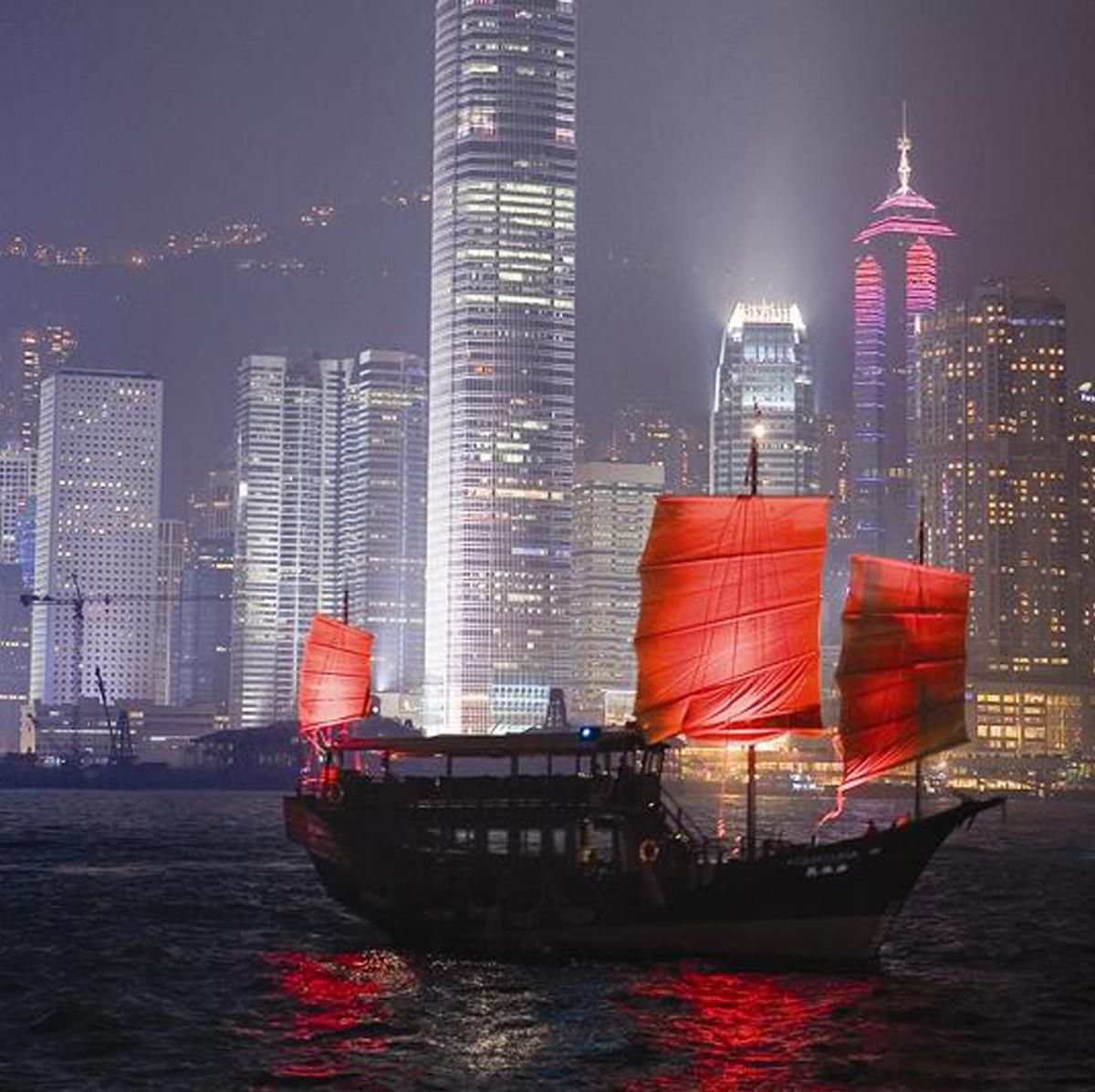
Culture & Heritage Tour, uncover the mysteries of the east from the comfort you can only experience with Peninsula Private Jet Tours
A family vacation by private jet not only eases the stresses of traveling with a family; it also provides a relaxing environment to connect and spend quality time together between destinations. Enjoy the ultimate family vacation in China with experiences ranging from a Chinese cooking lesson with a Peninsula Chef to painting lessons with the resident artist in Beijing’s Peninsula property to playing table tennis with a former Chinese Olympian. Other highlights on our Family Tour include, hand-feeding pandas and enjoying VIP access to the newly opened Shanghai Disney. We have curated only the best experiences to ensure that each member of the family is captivated and entertained, providing you with a relaxing, memorable and safe vacation abroad. Make your next family vacation one filled with unforgettable experiences sure to entertain, bring you closer together as a family and introduce your children to the magnificence of China.
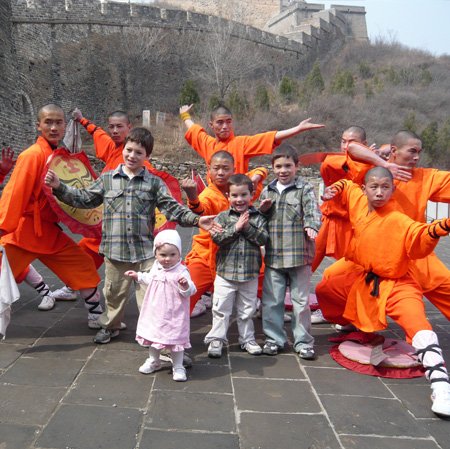
Family Tour, give your family an experience they will never forget from the safety and comfort of a Peninsula Private Jet Tour
China is a “must-eat” destination for foodies everywhere and our Culinary Voyage private jet tour offers the best China has to offer. Given our destinations of Beijing, Shanghai and Hong Kong, we focus on three main schools of cuisine; Imperial, Huaiyang and Cantonese from the perspective both of fine dining and home-style cooking. Together with Peninsula Hotels we have created a tour that provides exclusive access to Peninsula’s private kitchens as well as opportunities to learn, shop and cook with the best. For example, the Executive Chef of the Hong Kong Peninsula accompanies you on a traditional junk to his favorite island seafood bazaar. Alternatively, a TCM qualified nutritionist introduces you to China’s leading farm to table organic restaurant specializing in traditional cooking techniques. You will be introduced by experts to the art of preparing and cooking some of China’s most famous dishes from Peking duck in one of Beijing’s top duck restaurants to hand thrown noodles and dim sum. No matter your palette, our culinary tour will leave you with a newfound appreciation for the range and art of Chinese cooking.
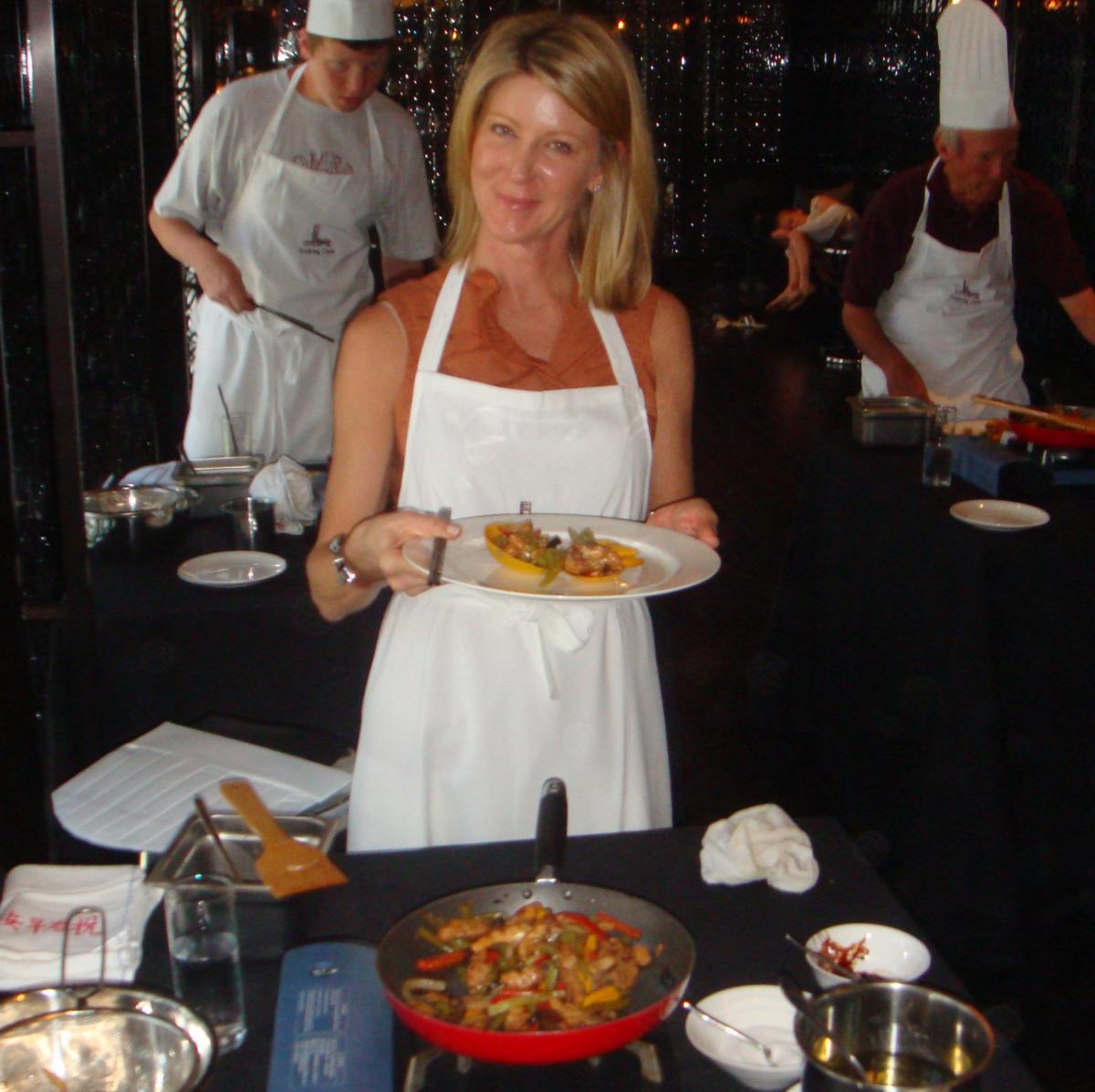
Culinary Voyage, learn the art of creating some of the most iconic dishes in Asia with Peninsula Hotels & Imperial Tours
Flying on a private jet not only enhances your comfort, it also allows you to see and do more in a shorter amount of time. These itineraries are so enriched with eye-opening activities and unusual experiences that you will be captivated from beginning to end.
Please join these scheduled departures, if you can. However, if are not able to make those departures but wish to take advantage of these itineraries, please do enquire. Not only can we supply various sized planes according to group, but we can tailor itineraries to visit other destinations. For example, a Culture and Heritage group might wish to add Hangzhou or Dunhuang, a family might be interested in Guilin and a culinary group might want to check out Chengdu to find our more about Sichuanese cuisine. Additionally, each itinerary is adaptable to include commerical flights instead of flying via private jet.
No matter what you wish to see and do in China, Imperial Tours together with Peninsula Hotels will endeavor to make your dream vacation a reality. Consider China a world undiscovered, a place rooted in an ancient history with a trajectory leaping into the future. Let Imperial Tours together with Peninsula Hotels help you uncover the mysteries of the East from the luxury, security and comfort of a private jet tour.

Ullens Center for Contemporary Art (UCCA)
China has some fabulous art galleries showcasing the best Chinese and international artists from past to present. Here we list some of the best places in the country to get yourself acquainted with the breadth of both Chinese and international art, in particular contemporary art.
Ullens Center for Contemporary Art (UCCA), Beijing
Located in the 798 Art Zone, the UCCA was designed to be a global art center in Beijing. It is a not-for-profit entity founded by Baron and Baroness Guy and Myriam Ullens de Schooten and inaugurated in November 2007. It offers exhibitions and programs which are designed to help visitors understand the art culture of China.
UCCA is based in three factory-chambers offering a total of approximately 10,000 square meters of international exhibition space. A peculiarity of UCCA is that all the exhibitions are all non-permanent thus it’s strongly recommended to get familiar with the current exhibitions before visiting UCCA in order to better enjoy them.
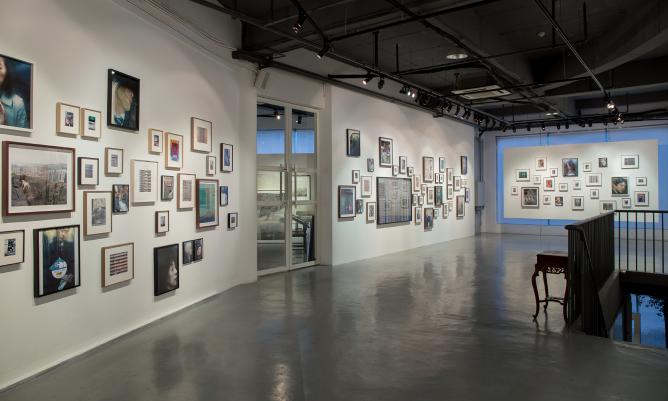
M97 photographic gallery in Shanghai
M97 Gallery, Shanghai
M97 is a photographic gallery established in 2006 in Shanghai, and is located in Shanghai's M50 neighborhood where former warehouses were turned into studios and galleries. It has a great selection of photography from Chinese and foreign photographers. It was one of the first photography galleries in China and the largest in Shanghai.
It is a 300 m² space with a 200 m² main exhibition room. Since its opening, their main focus was to expand the understanding and appreciation for the history and art of photography in China.
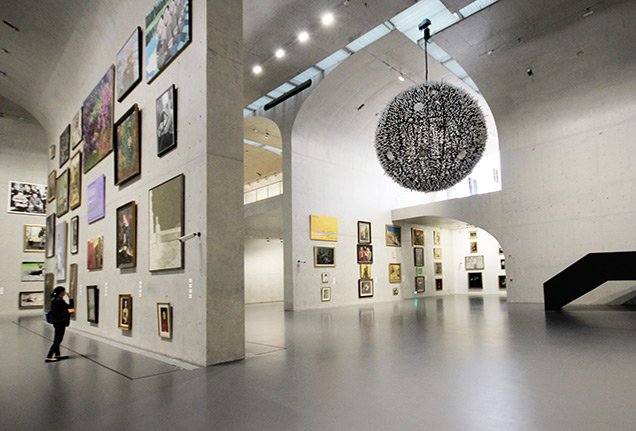
Long Museum West Bund
Long Museum, Shanghai
This is a private museum with two locations: Long Museum Pudong and Long Museum West Bund. The Long Museum Pudong opened in 2012 and is focused on high-quality Chinese art. It displays all types or genres: contemporary, modern, revolutionary and traditional. The Long Museum West Bund opened in 2014 and houses Chinese and European contemporary art as well as ancient and traditional Chinese masterpieces.

Heman Chong, “The Mysterious Island”, 2016 – Rockbund Art Museum
Rockbund Art Museum (RAM), Shanghai
This is a contemporary art museum placed in the former Royal Asiatic Society building, in the Bund area. It doesn’t have any permanent exhibitions but hosts short-term contemporary exhibitions by some of China and Asia’s most important artists. It was most recently hosting Singaporean artist Heman Chong.
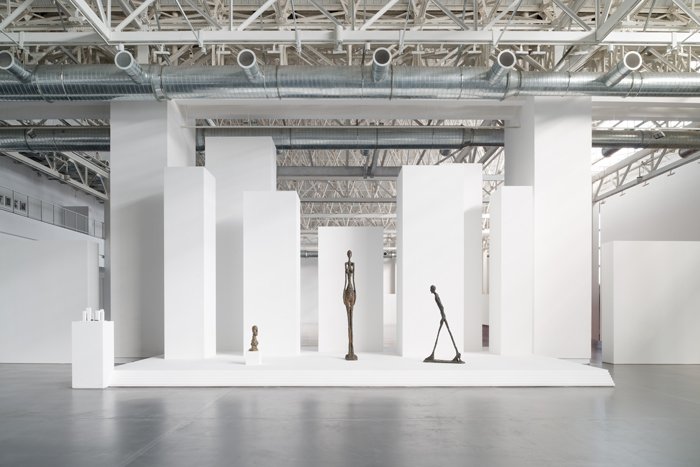
Alberto Giacometti at Yuz Museum
Yuz Museum, Shanghai
This museum belongs to the YUZ Foundation, founded by Mr. Budi Tek. It opened in 2014 and is the second museum of the Foundation after the YUZ Museum in Jakarta. It’s located in the Bund area and hosts mainly non-permanent exhibitions of Western and Eastern contemporary art. It is currently hosting Alberto Giacometti’s largest retrospective of sculptures until the end of July.
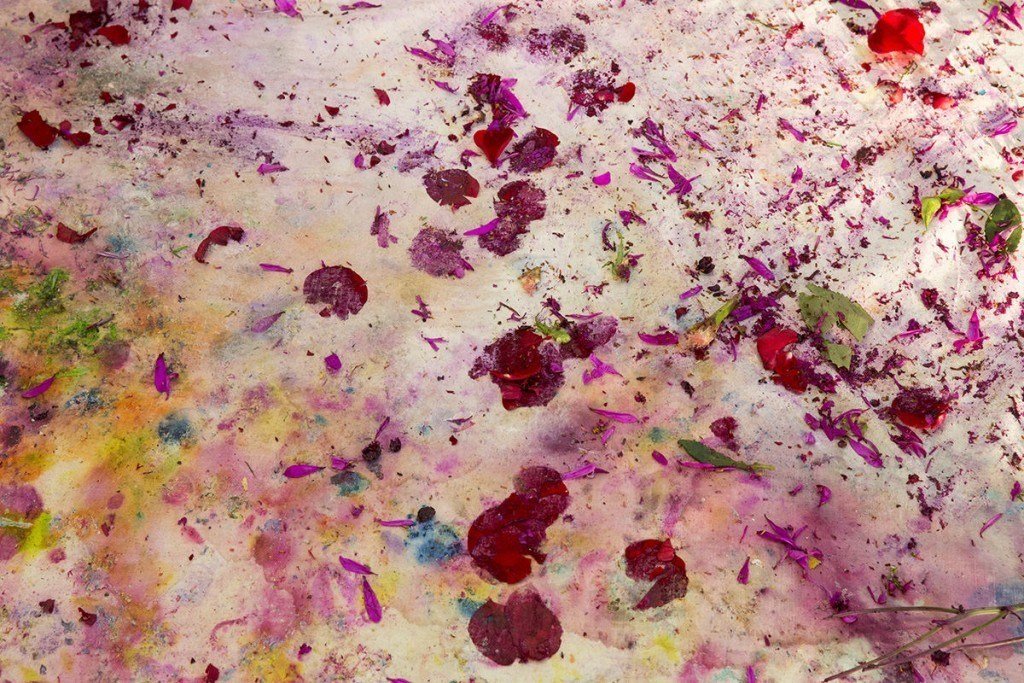
Dan Colen at the Gagosian
Gagosian Gallery, Hong Kong
Larry Gagosian opened his gallery in Hong Kong in 2010, having opened a total of 15 art galleries around the world including in New York, Paris and London. It’s located in the Pedder Building in the central shopping district and covers an area of 480 m2.
Gagosian’s exciting contemporary program features the work of leading international artists including Ellen Gallagher, Jeff Koons, Georg Baselitz and Andreas Gursky. It's most recent exhibition was “When I’m Gone” by Dan Colen.
Imperial Tours can custom design half-day, one-day and multi-day tours exploring contemporary art in China. Please contact us for more details.